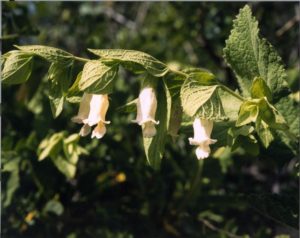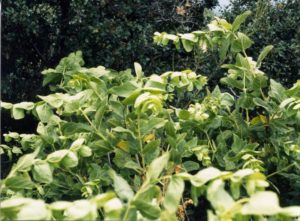Lepechinia rossii
- Sensitive – U.S. Forest Service
- Rare Plant Rank 1B.2 – California Native Plant Society
- G1 Critically Imperiled – NatureServe (2006)

Ross’ pitcher sage in bloom. Photo credit: Steve Boyd
Lepechinia rossii is a rare flowering plant that is commonly referred to as Ross’ pitcher sage, and can only be found along the western Transverse Ranges in Ventura and Los Angeles counties. Described as a shrub with purple, bell-shaped flowers growing in a cluster from the stem, Ross’ pitcher sage is usually less than five feet tall. This family of plants is highly aromatic, with oblong, drought-deciduous leaves and broad, tubular flowers.
This plant was first collected on Liebre Mountain in Los Angeles County in 1991, making this a relatively recent discovery. In 1995, Timothy Ross examined a collection of unidentified specimens from the Topatopa Mountains in Los Padres National Forest that appeared consistent with the discovery made in 1991. Ross’ connection between the two sample populations played a huge role in the understanding of Lepechinia rossii, and therefore the relatively newfound species was named in his honor.
Ross’ pitcher sage has only two known populations, which are located on Red Mountain in the Angeles National Forest and in the Sespe Creek watershed in Los Padres National Forest. At both sites, the plant is typically found in relatively open areas inhabited by chaparral vegetation and various shrubs, and is most abundant after wildland fires.

Ross’ pitcher sage in native habitat. Photo credit: Steve Boyd
Between the two populations, there are major threats that disturb the existence of Ross’ pitcher sage. In the Liebre Mountains, these threats are limited to mainly habitat disruption by off-highway vehicles and power line maintenance, which also disrupts the plant’s habitat. In the Topatopa Mountains, threats also include off-highway vehicle disturbances and petroleum exploration and extraction. As a species that is associated with post-fire succession of chaparral, another major threat to L. rossii is invasion by exotic grasses.
Although there are no active conservation efforts due to the unknown nature of the species, Angeles National Forest and Los Padres National Forest have Ross’ pitcher sage on their radar, and it is designated as a “sensitive species.” However, the plant has not been well-surveyed and much is still unknown about its current status.






